Human Wildlife Interactions : Conflict, Communication and Collaboration
Organised by Keystone Foundation and Tamil Nadu Forest Department-Coimbatore Circle
Date: 6-7 October 2015
Venue: Nahar Retreat, Kotagiri, Nilgiris Tamil Nadu.
Day 1: 06.10.2015
· The conference on Human Wildlife Interactions was inaugurated through a Dhupa ceremony.
· 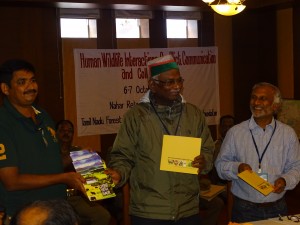 The first session began with Mr. Pratim Roy (Director Keystone Foundation), Mr. I Anwardeen IFS (Conserator of Forests, Coimbatore Circle), and Dr. AJT Johnsingh delivering individual addresses.
The first session began with Mr. Pratim Roy (Director Keystone Foundation), Mr. I Anwardeen IFS (Conserator of Forests, Coimbatore Circle), and Dr. AJT Johnsingh delivering individual addresses.
· Mr. Roy spoke of the changing perspective towards human wildlife interactions over the past few decades. He was of the opinion that the tolerance levels of people was waning, and the need of the hour was to move towards adaptive co-existence.
· Conservator of Forests, Mr Anwardeenmentioned the current perspective of the society towads the Forest Department as just custodians of wildlife. He opined that there was greater diversity in the roles the Forest Department plays beyond that stereotype. He also spoke of the different uses of biodiveristy in our daily lives, and our conception of these linkages. Human beings, according to him, are the biggest variables in this equation of interactions with nature. It would not be possible to have a seperate habitat for humans and another one for wildlife. The key towards moving towards co-existence is perhaps to highlight and promote the positive effects of these interactions, and if humans could be made to understand how to work with wildlife.
· 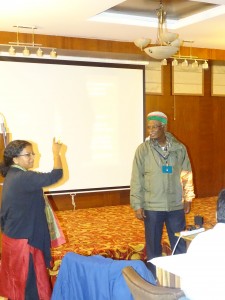 Dr. AJT Johnsingh started his presentation by talking of the various kinds of conflict across India, and the context in which incidents of interactions become conflict. He opined the conflict incidents began to increase when humans started practising agriculture, and there is a lot of superstition and misinformation about wildlife which is not true. He was also of the opinion that humans are majorly in conflict with about 7 orders of animals Primates (Rheses macaque, Bonnet macaque), Carnivora (Canidae, Ursidae, Herpesitidae, Hyneida, Felidae) were the major contributors towards these incidents. He also considered that there were a lot of unreported incidets involving some other species which was not focussed on. He concluded on the following points, (i) Without compensation, the tiger would be wiped out (ii) Hunting in certain areas of wild pig, leopard and nilgai should be allowed (iii) Large herbivores, like the gaur could perhaps be trasnloacted to a different place (like mukurthi) (iv) and that macaques should be tolerated, and we should not aid thier raiding habits by feeding them.
Dr. AJT Johnsingh started his presentation by talking of the various kinds of conflict across India, and the context in which incidents of interactions become conflict. He opined the conflict incidents began to increase when humans started practising agriculture, and there is a lot of superstition and misinformation about wildlife which is not true. He was also of the opinion that humans are majorly in conflict with about 7 orders of animals Primates (Rheses macaque, Bonnet macaque), Carnivora (Canidae, Ursidae, Herpesitidae, Hyneida, Felidae) were the major contributors towards these incidents. He also considered that there were a lot of unreported incidets involving some other species which was not focussed on. He concluded on the following points, (i) Without compensation, the tiger would be wiped out (ii) Hunting in certain areas of wild pig, leopard and nilgai should be allowed (iii) Large herbivores, like the gaur could perhaps be trasnloacted to a different place (like mukurthi) (iv) and that macaques should be tolerated, and we should not aid thier raiding habits by feeding them.
· A short discussion regarding the pros and cons of hunting animals followed the presentation, which ended up with Conservator suggesting site specific population control techniques. Mr. Mohan Raj also opined that translocation of Gaur was not a very good idea, as it might have severe negative repurcussions.
Theme 1: Human Influence and Wildlife
· The session was chaired by Mr. Anwardeen; he opened the session with his thoughts on the theme. He opined that this was a time for the ground level management of District Forest Officers, especially with increase in efficiency and the variety of modes of communication, is really important considering that the investment in the Forest Department is less. The major issues were the elephant and carnivore conflict.
· He also spoke of the government investment in physical barriers to mitigate conflict. Capture and translocation is also considered illegal, except under very special circumstances. While there were different measures that have been tried for elephants, he said, that not all of them had worked. Further, his objective of how to reduce conflict was by reducing the number of human deaths to a minimum number, install elephant crossings, as well as providing some basic facilities in areas where people were likely to be affected by elephants.
· He also suggested that maybe we were not looking at the right reasons as to why conflict between humans and wildlife was happening.
· Talks on Human Influence and Wildlife:
· Dr. Ravi Chellam, Foundation for Ecological Security
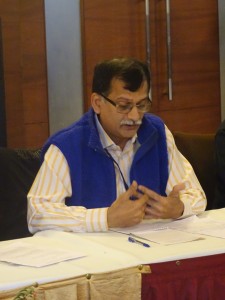 Dr. Chellam opined that we had done well at conservation so far, but there was a need to do better. According to him, human wildlife conflict was always blamed on animals, without for a second considering what wide range of human activities might have done to habitat for animals. He attributed this attitude towards what he considered the root cause – the current model of economic development. Conservation had become exclusive, and a lot of protected species were in unprotected areas. He considered the path we were on to be wrong, as he believed that there could not be a single universal conservation model, rather multiple modelswould be required to address the current situation. Considering the long term picture was of great importance to him, as well his belief that conservation succeeds because of co-existence.
Dr. Chellam opined that we had done well at conservation so far, but there was a need to do better. According to him, human wildlife conflict was always blamed on animals, without for a second considering what wide range of human activities might have done to habitat for animals. He attributed this attitude towards what he considered the root cause – the current model of economic development. Conservation had become exclusive, and a lot of protected species were in unprotected areas. He considered the path we were on to be wrong, as he believed that there could not be a single universal conservation model, rather multiple modelswould be required to address the current situation. Considering the long term picture was of great importance to him, as well his belief that conservation succeeds because of co-existence.
· Mr Bhoominathan Durairaj, World Wide Fund for Nature-India.
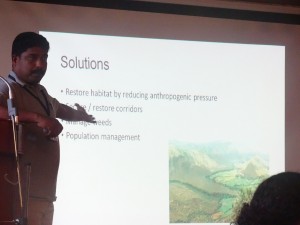 Mr. Bhoominathan discussed on the issue on human elephant conflict across the Western Ghats, and in the Nilgiri Biosphere Reserve. He called attention to the unique conflict situation in Nilgiris, with relation to human habitats and elephant habitats. While in his experience, in Hassan, there was not much habitat available for elephants, as they were occupying coffee plantations. He went on to mention different problematic areas around this landscape and described the scenario in each of those places. He then brought up the issue of different approaches in engaging with elephants in the form of physical barriers. He opined that most physical barriers and alternate cropping do not really work. He said they had designed a barrier which kept elephants out. He also mentioned his work with a radio collared elephant that was trans located, and the elephant’s journey back to the point of capture. He added that fragmented state of the landscape was worsening the scenario for the elephants, as well as certain incidents of barriers being improperly used. He also spoke of a low cost energiser which had been developed by them which would work effectively against elephants.
Mr. Bhoominathan discussed on the issue on human elephant conflict across the Western Ghats, and in the Nilgiri Biosphere Reserve. He called attention to the unique conflict situation in Nilgiris, with relation to human habitats and elephant habitats. While in his experience, in Hassan, there was not much habitat available for elephants, as they were occupying coffee plantations. He went on to mention different problematic areas around this landscape and described the scenario in each of those places. He then brought up the issue of different approaches in engaging with elephants in the form of physical barriers. He opined that most physical barriers and alternate cropping do not really work. He said they had designed a barrier which kept elephants out. He also mentioned his work with a radio collared elephant that was trans located, and the elephant’s journey back to the point of capture. He added that fragmented state of the landscape was worsening the scenario for the elephants, as well as certain incidents of barriers being improperly used. He also spoke of a low cost energiser which had been developed by them which would work effectively against elephants.
· Mr Sumin George Thomas – Keystone Foundation- Perceptions of Interactions in NBR
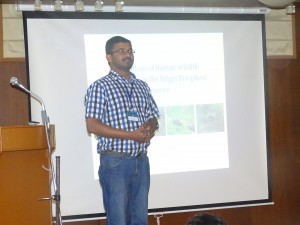 Mr. Thomas spoke of the different perceptions and kinds of damage, that were recorded by him regarding human wildlife conflict, across the NBR. He said that the survey hadbeen conducted in 8 zones over 62 villages. Their objective had been to survey the ecological attribute of the socio-economic structures, and ranking their perceptions of human wildlife conflict. He spoke about the perception across the broad categories of conflict, i.e., crop raiding ( seasonal issue, change in patterns over time, other reasons how crops might be affected), livestock depradation ( was a major issue in wayanad, seasonality is not observed in depradation of livestock, and most incidents occur in Reserve forests or village lands close to the forest, the varied perceptions of depradation and the time investment in safeguarding livestock), Wildlife attacks (24/62 villages reported wildlife attacks, mostly in reserve forests and fewer in village lands, perceptions regarding wildlife attacks were not very different), property damage (elephants attributed with causing most damage followed by gaur, the varied general attitudes towards wildlife, and the responsibility and responses to to conflict incidents). His major conclusion was that the attitudes of people towards wildlife strongly influenced their protection and co-existence and this would be a better place to focus on.
Mr. Thomas spoke of the different perceptions and kinds of damage, that were recorded by him regarding human wildlife conflict, across the NBR. He said that the survey hadbeen conducted in 8 zones over 62 villages. Their objective had been to survey the ecological attribute of the socio-economic structures, and ranking their perceptions of human wildlife conflict. He spoke about the perception across the broad categories of conflict, i.e., crop raiding ( seasonal issue, change in patterns over time, other reasons how crops might be affected), livestock depradation ( was a major issue in wayanad, seasonality is not observed in depradation of livestock, and most incidents occur in Reserve forests or village lands close to the forest, the varied perceptions of depradation and the time investment in safeguarding livestock), Wildlife attacks (24/62 villages reported wildlife attacks, mostly in reserve forests and fewer in village lands, perceptions regarding wildlife attacks were not very different), property damage (elephants attributed with causing most damage followed by gaur, the varied general attitudes towards wildlife, and the responsibility and responses to to conflict incidents). His major conclusion was that the attitudes of people towards wildlife strongly influenced their protection and co-existence and this would be a better place to focus on.
· Mr Tarshish Thekaekara – Shola Trust
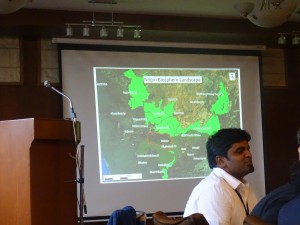 Mr. Thekaekara spoke on co-existence between humans and elephants in Gudalur. He was of the opinion that the conflict term does not occur, as the animals are not fighting proactively. His focus was on how to manage practical side by side living with elephants. He shared the results of a perception survey conducted among a few indigenous groups and settlers in Gudalur. He concluded that the tolerance levels among immigrant settlers were really low as compared to the local indigenous communities, and it was these attitudes that would determine if sharing of space was possible.
Mr. Thekaekara spoke on co-existence between humans and elephants in Gudalur. He was of the opinion that the conflict term does not occur, as the animals are not fighting proactively. His focus was on how to manage practical side by side living with elephants. He shared the results of a perception survey conducted among a few indigenous groups and settlers in Gudalur. He concluded that the tolerance levels among immigrant settlers were really low as compared to the local indigenous communities, and it was these attitudes that would determine if sharing of space was possible.
· Dr Tarun Chabbra – Todas and Tiger Interactions
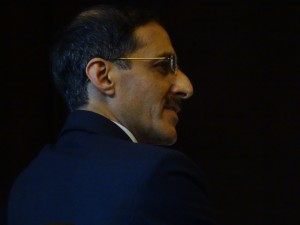 Dr Chabbra started by highlighting a unique characteristic of the Todas, their choice to be vegetarian, as well their intricate connection with their buffaloes. Historically, they reared large number of buffaloes, but as the population has come down, there has been an increase in carnivore attack on the buffaloes. The todas, would also be unwilling to claim compensation, as they believed that a buffalo killed by a tiger is a blessing. He concluded by asking if the buffaloes need to save or the tiger does.
Dr Chabbra started by highlighting a unique characteristic of the Todas, their choice to be vegetarian, as well their intricate connection with their buffaloes. Historically, they reared large number of buffaloes, but as the population has come down, there has been an increase in carnivore attack on the buffaloes. The todas, would also be unwilling to claim compensation, as they believed that a buffalo killed by a tiger is a blessing. He concluded by asking if the buffaloes need to save or the tiger does.
· The session was then thrown open for discussion by the participants. The following are the major points that were discussed:
o Threat perceptions and its relation fo public outcry, rather than intensity of the incident itself, the need for landscape based conflict mitigation was also advocated.
o It was opined that a mid ground was needed to manage conflict on a daily basis.
o It was indicated that there was no room for an either/or solution, andthe onus for responisbility for dealing with conflict was with everybody.
o It was indicated that we had to get back to the drawing board, and reconsider our approaches. It was also suggested that society needs to think and learn how to co-exist with animals, and perhaps there was need for a different mode of education to cater to this need as well.
o There was also further discussion on fencing and the isolation and fragmentation of functional ecosystems, as well as the different conservation models that had worked in the past, the varied roles of the Forest Department and the perception of its roles in society.
Theme 2 : Communication and Collaboration
· 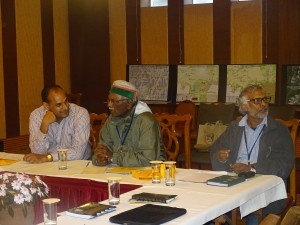 Mr Srinivasa Reddy, IFS Field Director Mudumalai Tiger Reserve chaired the session for discussion on the theme of Communication and Collaboration. He highlighted the differences in the inteactions between indigenous communities and other settlers in the region, also the manner in which usage of spaces happened. He also opined that before technology could be used to tackle conflict issues, ownership of these incidents had to be taken up.
Mr Srinivasa Reddy, IFS Field Director Mudumalai Tiger Reserve chaired the session for discussion on the theme of Communication and Collaboration. He highlighted the differences in the inteactions between indigenous communities and other settlers in the region, also the manner in which usage of spaces happened. He also opined that before technology could be used to tackle conflict issues, ownership of these incidents had to be taken up.
· Talks on Communication and Collaboration:
· Mr. Abhishek K R, Keystone Foundation
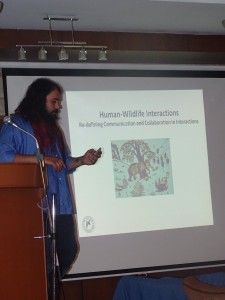 Mr. Abhishek spoke of the different modes through which conflict is understood and its relation to the mechanism of compensation. He also highlighted the common perception that the Forest Department was considered responsible for the various kinds of negative interactions between humans and wildlife. He shared findings from a few stakeholder workshops that had been conducted before, and the need was not just to document, but also to facilitate space for interaction and collaboration. He also spoke on possibly re-defining roles in conflict, in a few major issues such as waste management, management of natural resources, planning infrastructure and awareness.
Mr. Abhishek spoke of the different modes through which conflict is understood and its relation to the mechanism of compensation. He also highlighted the common perception that the Forest Department was considered responsible for the various kinds of negative interactions between humans and wildlife. He shared findings from a few stakeholder workshops that had been conducted before, and the need was not just to document, but also to facilitate space for interaction and collaboration. He also spoke on possibly re-defining roles in conflict, in a few major issues such as waste management, management of natural resources, planning infrastructure and awareness.
· Mr Rahul Meesaraganda – Talking for the Wild
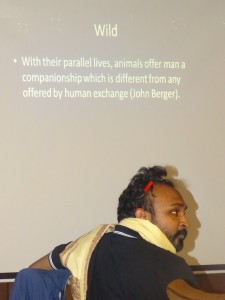 Mr. Rahul spoke of the scenario facing reporters who do wildlife stories and some of the practical difficulties, and scenarios which local reporters might be faced with. He also highlighted the influence of large corportations which own these companies on the stories published by them. He believed that conducting specialised workshop for the media might be of great use, and sensitising them to environmental concerns, would give way to a lot of different perspectives towards the media getting shared. He also suggested the use of a lot of non-mainstream spaces to share infomartion and communicate ideas.
Mr. Rahul spoke of the scenario facing reporters who do wildlife stories and some of the practical difficulties, and scenarios which local reporters might be faced with. He also highlighted the influence of large corportations which own these companies on the stories published by them. He believed that conducting specialised workshop for the media might be of great use, and sensitising them to environmental concerns, would give way to a lot of different perspectives towards the media getting shared. He also suggested the use of a lot of non-mainstream spaces to share infomartion and communicate ideas.
· Mr. N S Tejaswi, IFS –District Forest Officer, Gudalur
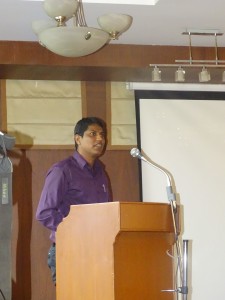 Mr Tejaswi highlighted the need for better communication between different government departments as well between the departments and public, NGOs and the media. He spoke about the various pre-conceived ideas about conflict that people had and together with better communication means, small situations could quickly escalate into to a mob scenario. He indicated the current emphasis on agriculture and and existing perceptions of conflict and the roles the Forest Department has to play in it are rather unfair. He also questioned the need to compromise with each different stakeholder and to what extent that compromise should be. In his talk he also provided valuable insights into the daily difficulties of being a Forest Department Official in a conflict rich zone like Gudalur, as well advoacted the use of Sec. 144 and sec. 174 in cases of dealing with incidents of conflict.
Mr Tejaswi highlighted the need for better communication between different government departments as well between the departments and public, NGOs and the media. He spoke about the various pre-conceived ideas about conflict that people had and together with better communication means, small situations could quickly escalate into to a mob scenario. He indicated the current emphasis on agriculture and and existing perceptions of conflict and the roles the Forest Department has to play in it are rather unfair. He also questioned the need to compromise with each different stakeholder and to what extent that compromise should be. In his talk he also provided valuable insights into the daily difficulties of being a Forest Department Official in a conflict rich zone like Gudalur, as well advoacted the use of Sec. 144 and sec. 174 in cases of dealing with incidents of conflict.
· Dr T R Shankar Raman, Nature Conservation Foundation – Creating a landscape of co-existence and wildlife
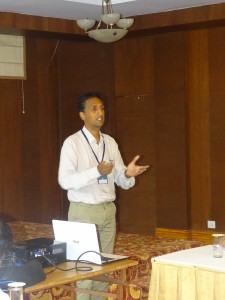 Dr Shankar Raman spoke of the various ways in which people react in a landscape to conflict. He highlighted the support needed from the Forest Department as well as large plantation owners in working towards mitigating conflict. He attributed part of the problem to the fragmentation of the landscape, which he believed had further lead to the fragmentation of distribution of fauna. With regard to conflict with elephants, he believed most deaths occurred as unexpected incidents, which were caused by the lack of basic facilities in areas with high wildlife density. Catering to these facilities as well as considering the dynamics of the way in which a landscape functions, especially in terms of the relations between humans and wildlife, and moving to more proactive measures in mitigation conflict/supporting interactions, as well as using the right kind of language while describing our interactions with Nature could be the key to engaging with this problem.
Dr Shankar Raman spoke of the various ways in which people react in a landscape to conflict. He highlighted the support needed from the Forest Department as well as large plantation owners in working towards mitigating conflict. He attributed part of the problem to the fragmentation of the landscape, which he believed had further lead to the fragmentation of distribution of fauna. With regard to conflict with elephants, he believed most deaths occurred as unexpected incidents, which were caused by the lack of basic facilities in areas with high wildlife density. Catering to these facilities as well as considering the dynamics of the way in which a landscape functions, especially in terms of the relations between humans and wildlife, and moving to more proactive measures in mitigation conflict/supporting interactions, as well as using the right kind of language while describing our interactions with Nature could be the key to engaging with this problem.
· Dr Prachi Mehta, WildlifeResearch and Conservation Society, Art of living with Elephants
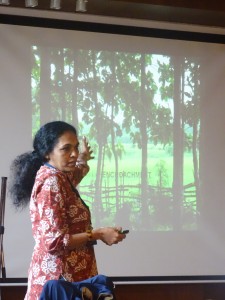 Dr Prachi spoke about the current scenario of elephants in the Dandeli region. She mentioned the changing landscapes ans well as the increase in weeds in the region, and the effects it was having on the resident elephant population. She went on to talk about different mitigation techniques she has been advocating in the region, which were effective and cost effective as well. She also touched upon the challenges of community based conflict management and the expectancy of the farmers on the government to tackle these problems as well as provide benefits. She mentioned that her approach was to go low-cost low-tech in her approach in designing mitigation barriers, and that another major motive was for the farmers to take up ownership and maintenance of these mitigation measures.
Dr Prachi spoke about the current scenario of elephants in the Dandeli region. She mentioned the changing landscapes ans well as the increase in weeds in the region, and the effects it was having on the resident elephant population. She went on to talk about different mitigation techniques she has been advocating in the region, which were effective and cost effective as well. She also touched upon the challenges of community based conflict management and the expectancy of the farmers on the government to tackle these problems as well as provide benefits. She mentioned that her approach was to go low-cost low-tech in her approach in designing mitigation barriers, and that another major motive was for the farmers to take up ownership and maintenance of these mitigation measures.
Day 2: 07.10.2015
· Ms. Radhika Timbadia, Snow Leopard Trust/Nature Conservation Foundation‘Living with Snow Leopards”.
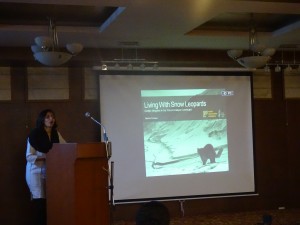 Ms. Timbadia spoke on the low density of wildlife in the region of her study, different techniques used to mitigate predator attacks, and various incentive models they had used to promote co-existence. She spoke of an Insurance scheme which had been setup by them with the help for the villagers to insure each of their livestock, as well various livelihood enterprises and the dynamics of the way each of these systems worked. One of the main highlights of her talk was the crucial role the community was playing in conservation in this region, and how their perspective towards conflict is very different.
Ms. Timbadia spoke on the low density of wildlife in the region of her study, different techniques used to mitigate predator attacks, and various incentive models they had used to promote co-existence. She spoke of an Insurance scheme which had been setup by them with the help for the villagers to insure each of their livestock, as well various livelihood enterprises and the dynamics of the way each of these systems worked. One of the main highlights of her talk was the crucial role the community was playing in conservation in this region, and how their perspective towards conflict is very different.
Session 1 – Investing in Interactions
· Dr. Ravi Chellam was the chair for the session on Investing in Interactions; he touched upon the need for better documentation of conflict as well to start learning from strategies which have failed in the past.
· Mr. Ganesh Raghunathan, Nature Conservation Foundation – Elephants in our backyards : Conflict to co-existence
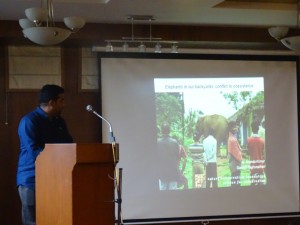 Mr. Ganesh spoke on the elephant conflict scenario in Valparai and some of the reasons behind the occurence of these incidents. He attributed some of these incidents to structural changes in eco-sensitive zones, fragmentation of landscapes. To engage with this issue, and to better understand it he had to identify conflict hotspots, reason for conflict and circumstances of death. His research has shown that most elephant deaths in this region occurs due to lack of awareness of the presence of elephants.
Mr. Ganesh spoke on the elephant conflict scenario in Valparai and some of the reasons behind the occurence of these incidents. He attributed some of these incidents to structural changes in eco-sensitive zones, fragmentation of landscapes. To engage with this issue, and to better understand it he had to identify conflict hotspots, reason for conflict and circumstances of death. His research has shown that most elephant deaths in this region occurs due to lack of awareness of the presence of elephants.
To counter this issue, the NCF team in collaboration with the Forest Department had setup a message alert system as well as elephant alert lights, which would provide information of the movement of elephants in the region, and alert people so as to minimise negative interactions and reduce conflict. These methods, according to him helped restore faith of the local populace in the forest department. Also he said there was a positive response from the community in terms of taking ownership of these alert systems, as the number of deaths due to accidents with elephants had been coming down drastically over the years, leading to the locals having more confidence in the system and their desire to take ownership of it.
· Mr Raj Kumar K , District Forest Officer- Sathyamangalam – Man – animal conflict –Field Observations
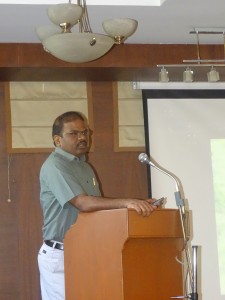 Mr. Rajkumar was of the opinion that physical mitigation measures such as Trenches, Fences, Chilli powder and other such measures were not foolproof solutions He went on to illustrate how these measures were not, and where an accidental oversight could result in a serious problem. He also highlighted that there had been a trend of tampering with electric fences particularly, which had resulted in the increase in number of deaths of animals dying because of electrocution. He said the major problematic animal in his region was the elephants, and there had been a few recordings of electrocutions in the area. He also spoke of the movements of elephants in the region, and the major areas where conflict was currently occuring.
Mr. Rajkumar was of the opinion that physical mitigation measures such as Trenches, Fences, Chilli powder and other such measures were not foolproof solutions He went on to illustrate how these measures were not, and where an accidental oversight could result in a serious problem. He also highlighted that there had been a trend of tampering with electric fences particularly, which had resulted in the increase in number of deaths of animals dying because of electrocution. He said the major problematic animal in his region was the elephants, and there had been a few recordings of electrocutions in the area. He also spoke of the movements of elephants in the region, and the major areas where conflict was currently occuring.
· Ms Archana S- Keystone Foundation – A fence in Banglapadigai
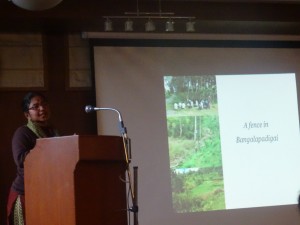 Ms. Archana presented an interesting narrative on Banglapadigai, an Irula Settlement which was traditionally governed, and was facing conflict with elephants in the region. She also mentioned that there had been disagreements in the team regarding the installation of a fence in this region to prevent crop damage from occuring. She also shared a survey which she had done in the region, and that she arrived at the idea that it might be better to fence off smaller patches rather than larger patches which might end up blocking elephant routes in the area. Part of this initiative she mentioned was to also bring agricultural security to the people, and also to attract migrants from this village to return to traditional practices.
Ms. Archana presented an interesting narrative on Banglapadigai, an Irula Settlement which was traditionally governed, and was facing conflict with elephants in the region. She also mentioned that there had been disagreements in the team regarding the installation of a fence in this region to prevent crop damage from occuring. She also shared a survey which she had done in the region, and that she arrived at the idea that it might be better to fence off smaller patches rather than larger patches which might end up blocking elephant routes in the area. Part of this initiative she mentioned was to also bring agricultural security to the people, and also to attract migrants from this village to return to traditional practices.
She also spoke of an electric fence which had been erected in collaboration with WWF and the local community who had undertaken ownership for the maintenance of the fence as well as contributing to the final cost of the fence.
· Mr. S. Badraswamy – District Forest Officer -Nilgiris South
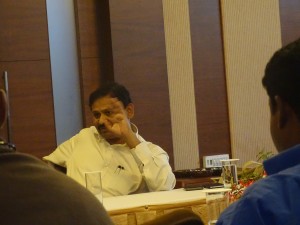 Mr. Badraswamy spoke briefly on the change in animal behaviour, managing and understanding elephant movement patterns, and community participation on conflict mitigation. Encroachers are a major part of the problem according to him, and maintenance of physical mitigation measures was another point of concern. He also focussed on the different ways in which conflict mitigation could occur with greater participation from the community.
Mr. Badraswamy spoke briefly on the change in animal behaviour, managing and understanding elephant movement patterns, and community participation on conflict mitigation. Encroachers are a major part of the problem according to him, and maintenance of physical mitigation measures was another point of concern. He also focussed on the different ways in which conflict mitigation could occur with greater participation from the community.
· Dr. B.A. Daniel – Zoo Outreach Organisation
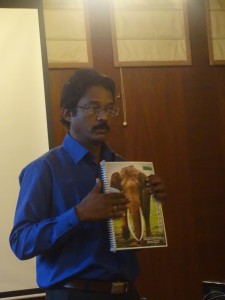 Mr. Daniel spoke briefly about the need for better conservation and environmental education. He spoke in detail about the different methods that could be used to engage with public about conservation and environmental issues,as well the different themes that could be touched upon. Specifically talking about the Human Elephant Co-existence module,he illustrated the importance of each of the components of the kit and the design logic behind each of the items present. He also spoke of the success of this module in spreading awareness about co-existence.
Mr. Daniel spoke briefly about the need for better conservation and environmental education. He spoke in detail about the different methods that could be used to engage with public about conservation and environmental issues,as well the different themes that could be touched upon. Specifically talking about the Human Elephant Co-existence module,he illustrated the importance of each of the components of the kit and the design logic behind each of the items present. He also spoke of the success of this module in spreading awareness about co-existence.
· Concluding Comments:
o The concluding comments were centred on the discussion what possibilities of communication and collaboration were available and how best to access them.
o There was an overall consensus that greater collaboration is needed between different arms of the government, and there has to be shared responsibility for environmental concerns. There was also a suggestion that NGO’s could help by facilitating collaborations between different departments and in various capacities, as well as to empower communities to engage with the department. The need for open sharing of information as well as transparency in our actions might increase chances of communication and collaboration was a thought generally agreed upon. There was also a discussion as to determine a landscape to start work on attempting different approaches towards mitigating the issues of conflict, which was later decided as the ecological boundaries of the Nilgiri Biosphere Reserve, and different approaches would be tried out, such as raising awareness, influencing perceptions, and simple mitigation measures.

